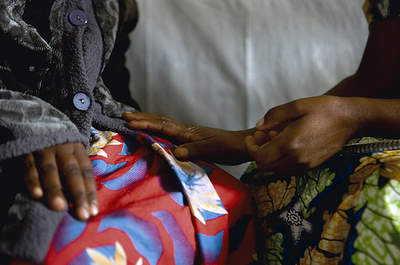The Red Cross is 150 years young.

A counselor listens to a rape victim at an ICRC-supported "listening house" one of numerous such sanctuaries near the fighting in the DRC where victims can receive medical support and emotional support.
On 24 June 1859, during the War of Italian Unification, Franco-Sardinian forces clashed with Austrian troops near the small town of Solferino in northern Italy. More than nine thousand wounded took refuge in the village of Castiglione, lying dispersed and unattended.
On that day, a gentleman by the name of Henry Dunant, a citizen of Geneva, Switzerland, was travelling in the area. He was shaken by the human suffering, resulting from the war. He mobilized a small army himself. An army of local volunteers, mostly women to care for the wounded, wash and dress their wounds, and to provide shelter and basic food.
In 1862 he published a book entitled "A Memory of Solferino", in which he described the battle and the wounded of the Chiesa Maggiore, concluding with a question:
"Would it not be possible, in time of peace and quiet, to form relief societies for the purpose of having care given to the wounded in wartime by zealous, devoted and thoroughly qualified volunteers?"
That question would set the basic principle of the International Red Cross and Red Crescent Movement, which is now to the largest humanitarian network in the world.
Dunant also asked the military authorities of various countries another basic question:
..whether they could formulate "(...) some international principle, sanctioned by a convention and inviolate in character, which, once agreed upon and ratified, might constitute the basis for societies for the relief of the wounded in the different European countries?".
This second question was the basis for The Geneva Conventions.
2009 marks 150th anniversary of the battle of Solferino and the 60th anniversary of the four Geneva Conventions. To put these anniversaries into the spotlight, the Red Cross Movement has launched a campaign, Our World. Your Move, to remind everyone of our individual responsibility to lessen human suffering.
The photography exhibition "Our World at War," scheduled to tour 41 countries, is one of the events of this campaign. Life magazine features several of the pictures.
Picture courtesy Ron Haviv (ICRC - VII)
 Peter. Flemish, European, aid worker, expeditioner, sailor, traveller, husband, father, friend, nutcase. Not necessarily in that order.
Peter. Flemish, European, aid worker, expeditioner, sailor, traveller, husband, father, friend, nutcase. Not necessarily in that order.
0 comments:
Post a Comment